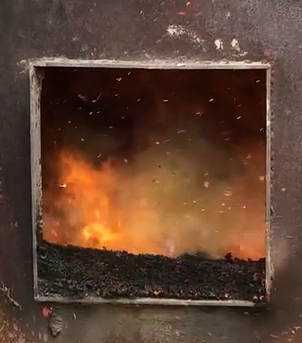Pyrolysis is a process that occurs when you heat material (in our case woody waste) to around 300 – 6500C, and exclude oxygen. All the ‘volatile’ organic compounds get driven off, together with water vapour, methanol, and eventually flammable vapours such as methane, hydrogen and carbon monoxide. What’s left is a stable carbon matrix that is very porous.
Our process captures the excess heat energy and uses it to kiln dry timber which is then used to make long lasting garden beds, cabins, chicken houses and more. It also captures the volatile flammable gases, and feeds them back into the pyrolysis kiln.

Because of the huge surface area of biochar at a microscopic level, it is very good at absorbing air, water and soluble plant nutrients, like a sponge. In poor sandy soils this can be a big help in preventing valuable nutrients from being washed through the soil and lost below the root zone.
Biochar also acts like an electro-chemical sponge, and can adsorb and hold onto charged nutrients (eg cations like sulphate and phosphate), which again is helpful in poor soils with a low cation exchange capacity.
The porous stable structure of biochar also provides habitat for soil organisms, bacteria and fungi, which are essential for healthy soil and release of nutrients from decaying organic matter. The carbon structures in biochar are very long lived, and wont break down in decades or even centuries.
Biochar is not a fertiliser on its own. It can help make best use of any fertiliser that you apply to the soil. Trials conducted in Tasmania and all over the world have shown positive results in yield and quality of fruit and vegies from adding it to soil. Some trials have shown negative results too. If you add raw, fresh biochar to the soil that hasn’t been “charged” with nutrients, there can be negative effects in the short term, as the biochar binds with nutrients it finds in the soil and can make them unavailable to plants.
The stable carbon structure of biochar, with its ability to adsorb toxins and provide niche habitat for gut flora, means that it has proven beneficial in many livestock systems around the world, including in Australia.
Adding biochar to feed for cattle, poultry and other livestock has improved animal health, feed conversion, and reduced odour of manure and reliance on antibiotics.
Biochar in bedding systems also reduces odour, and can make the manures easier to handle and convert to valuable compost for application on farm.
The New Black Biochar is made from sustainably sourced waste organic material such as sawmill waste, agricultural residues, and municipal green waste. If these waste streams are not used for biochar production, they will eventually decompose, releasing CO2 as they do so. Biochar production represents a way to sequester the carbon permanently, and provide cascading beneficial uses in the process.
Biochar can be made from almost any organic source; however we strongly advocate for using waste streams rather than growing crops just to convert to biochar. There are endless volumes of ‘unloved biomass’ available from crop residues, municipal green waste, tree clearing around infrastructure such as powerlines, sewerage sludge, poultry litter, and many other sources.
